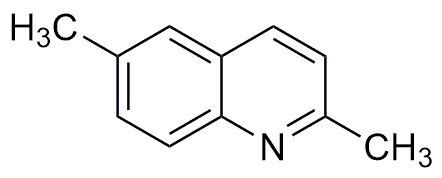2,6-Dimethylquinoline is widely utilized in research focused on:
- Organic Synthesis: This compound serves as a versatile building block in the synthesis of various organic molecules, particularly in the development of pharmaceuticals and agrochemicals.
- Fluorescent Dyes: It is used in the production of fluorescent dyes, which are essential in biological imaging and diagnostics, enhancing visibility in research applications.
- Chemical Intermediates: 2,6-Dimethylquinoline acts as an important intermediate in the manufacturing of specialty chemicals, providing unique properties that improve product performance.
- Corrosion Inhibitors: This compound is formulated into corrosion inhibitors for metals, particularly in the automotive and aerospace industries, offering superior protection compared to traditional inhibitors.
- Research in Material Science: It is employed in the study of new materials, particularly in the development of polymers and coatings that require enhanced thermal stability and chemical resistance.
General Information
Properties
Safety and Regulations
Applications
2,6-Dimethylquinoline is widely utilized in research focused on:
- Organic Synthesis: This compound serves as a versatile building block in the synthesis of various organic molecules, particularly in the development of pharmaceuticals and agrochemicals.
- Fluorescent Dyes: It is used in the production of fluorescent dyes, which are essential in biological imaging and diagnostics, enhancing visibility in research applications.
- Chemical Intermediates: 2,6-Dimethylquinoline acts as an important intermediate in the manufacturing of specialty chemicals, providing unique properties that improve product performance.
- Corrosion Inhibitors: This compound is formulated into corrosion inhibitors for metals, particularly in the automotive and aerospace industries, offering superior protection compared to traditional inhibitors.
- Research in Material Science: It is employed in the study of new materials, particularly in the development of polymers and coatings that require enhanced thermal stability and chemical resistance.
Documents
Safety Data Sheets (SDS)
The SDS provides comprehensive safety information on handling, storage, and disposal of the product.
Product Specification (PS)
The PS provides a comprehensive breakdown of the product’s properties, including chemical composition, physical state, purity, and storage requirements. It also details acceptable quality ranges and the product's intended applications.
Certificates of Analysis (COA)
Search for Certificates of Analysis (COA) by entering the products Lot Number. Lot and Batch Numbers can be found on a product’s label following the words ‘Lot’ or ‘Batch’.
Número de catálogo
Número de lote/lote
Certificates Of Origin (COO)
This COO confirms the country where the product was manufactured, and also details the materials and components used in it and whether it is derived from natural, synthetic, or other specific sources. This certificate may be required for customs, trade, and regulatory compliance.
Número de catálogo
Número de lote/lote
Safety Data Sheets (SDS)
The SDS provides comprehensive safety information on handling, storage, and disposal of the product.
DownloadProduct Specification (PS)
The PS provides a comprehensive breakdown of the product’s properties, including chemical composition, physical state, purity, and storage requirements. It also details acceptable quality ranges and the product's intended applications.
DownloadCertificates of Analysis (COA)
Search for Certificates of Analysis (COA) by entering the products Lot Number. Lot and Batch Numbers can be found on a product’s label following the words ‘Lot’ or ‘Batch’.
Número de catálogo
Número de lote/lote
Certificates Of Origin (COO)
This COO confirms the country where the product was manufactured, and also details the materials and components used in it and whether it is derived from natural, synthetic, or other specific sources. This certificate may be required for customs, trade, and regulatory compliance.

